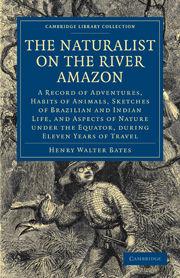 The Naturalist on the River Amazon
The Naturalist on the River Amazon Published online by Cambridge University Press: 29 August 2010
As may have been gathered from the remarks already made, the neighbourhood of Ega was a fine field for a Natural History collector. With the exception of what could be learnt from the few specimens brought home, after transient visits, by Spix and Martius and the Count de Castelnau, whose acquisitions have been deposited in the public museums of Munich and Paris, very little was known in Europe of the animal tenants of this region; the collections that I had the opportunity of making and sending home attracted, therefore, considerable attention. Indeed, the name of my favourite village has become quite a household word amongst a numerous class of Naturalists, not only in England, but abroad, in consequence of the very large number of new species (upwards of 3,000) which they have had to describe, with the locality “ Ega” attached to them. The discovery of new species, however, forms but a small item in the interest belonging to the study of the living creation. The structure, habits, instincts, and geographical distribution of some of the oldest-known forms supply inexhaustible materials for reflection. The few remarks I have to make on the animals of Ega will relate to the mammals, birds, and insects, and will sometimes apply to the productions of the whole Upper Amazons region. We will begin with the monkeys, the most interesting, next to man, of all animals.
To save this book to your Kindle, first ensure [email protected] is added to your Approved Personal Document E-mail List under your Personal Document Settings on the Manage Your Content and Devices page of your Amazon account. Then enter the ‘name’ part of your Kindle email address below. Find out more about saving to your Kindle.
Note you can select to save to either the @free.kindle.com or @kindle.com variations. ‘@free.kindle.com’ emails are free but can only be saved to your device when it is connected to wi-fi. ‘@kindle.com’ emails can be delivered even when you are not connected to wi-fi, but note that service fees apply.
Find out more about the Kindle Personal Document Service.
To save content items to your account, please confirm that you agree to abide by our usage policies. If this is the first time you use this feature, you will be asked to authorise Cambridge Core to connect with your account. Find out more about saving content to Dropbox.
To save content items to your account, please confirm that you agree to abide by our usage policies. If this is the first time you use this feature, you will be asked to authorise Cambridge Core to connect with your account. Find out more about saving content to Google Drive.